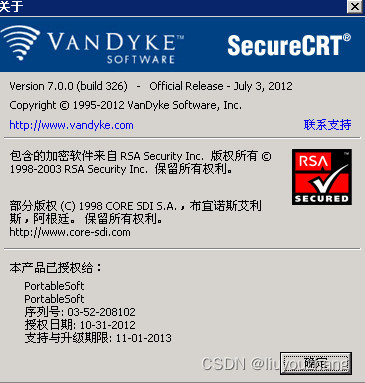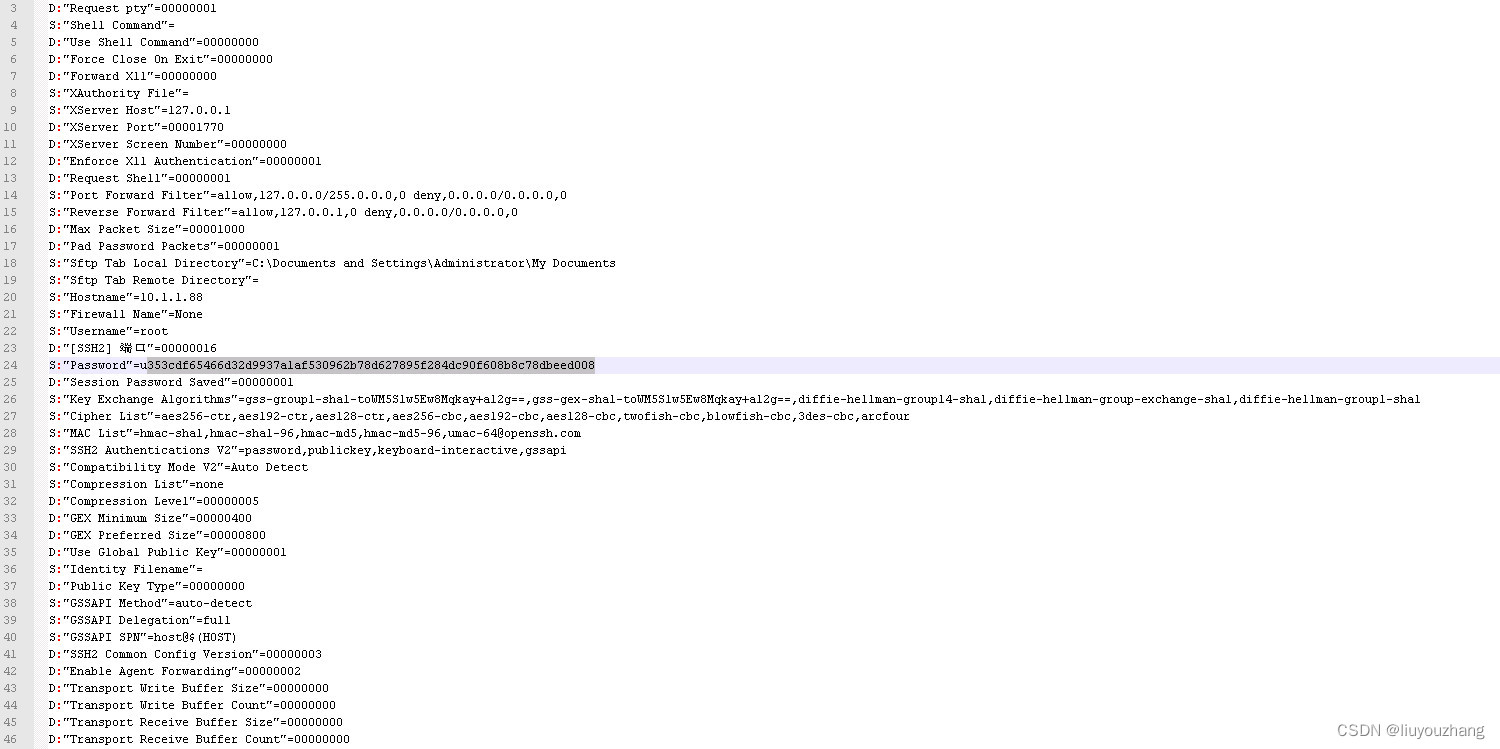SecureCRT登录会话密码解密_securecrt密码解密-程序员宅基地
技术标签: python
此文章是针对忘记了SecureCRT登录时输入的密码,选择了保存密码,后面忘记了密码,需要通过SecureCRT的密码保存记录,恢复找回机器登录密码的情况。
以下为我的操作步骤,特此记录,以备忘。
环境:Python3.7,win10 64位,PyCharm2020.1
由于解密的代码,用到了python的crypto这个库,因此需要先安装。注意下面pycryptodome,就是windows平台的安装的软件名称,不用怀疑,安装了这个就可以了。
安装pycrypto,pip install pycryptodome (windows平台是这个)

打开SecureCRT软件,依次打开 选项->全局选项->常规->配置文件夹,可以看到会话保存文件,每个文件名称以保存时的会话名称命名,找到需要解密的会话对应的文件,用文本编辑软件打开。

打开各IP地址对应的会话的登录配置信息文件(.ini结尾),如下位置,可以看到密码的密文 ,这里我们的SecureCRT是7.0的版本,密文前面带一个字母u前缀,把前缀去掉,拷贝后面的一串密文。 注意不同的SecureCRT版本,这里的密文的前缀可能不同。
 在PyCharm中,打开控制台命令行,运行
在PyCharm中,打开控制台命令行,运行
python SecureCRTDecrypt.py dec "353cdf65466d32d9937a1af530962b78d627895f284dc90f608b8c78dbeed008" (python37_env01) C:\Users\mythinkpadpc\PycharmProjects\pythonProject\SecureCRT>python SecureCRTDecrypt.py dec "353cdf65466d32d9937a1af530962b78d627895f284dc90f608b8c78dbeed008"
(输出密码明文)root.88
即可在控制台看到输出结果。
付完整代码,方便没梯子的同学:
#!/usr/bin/env python3
import os
from Crypto.Hash import SHA256
from Crypto.Cipher import AES, Blowfish
class SecureCRTCrypto:
def __init__(self):
'''
Initialize SecureCRTCrypto object.
'''
self.IV = b'\x00' * Blowfish.block_size
self.Key1 = b'\x24\xA6\x3D\xDE\x5B\xD3\xB3\x82\x9C\x7E\x06\xF4\x08\x16\xAA\x07'
self.Key2 = b'\x5F\xB0\x45\xA2\x94\x17\xD9\x16\xC6\xC6\xA2\xFF\x06\x41\x82\xB7'
def Encrypt(self, Plaintext: str):
'''
Encrypt plaintext and return corresponding ciphertext.
Args:
Plaintext: A string that will be encrypted.
Returns:
Hexlified ciphertext string.
'''
plain_bytes = Plaintext.encode('utf-16-le')
plain_bytes += b'\x00\x00'
padded_plain_bytes = plain_bytes + os.urandom(Blowfish.block_size - len(plain_bytes) % Blowfish.block_size)
cipher1 = Blowfish.new(self.Key1, Blowfish.MODE_CBC, iv=self.IV)
cipher2 = Blowfish.new(self.Key2, Blowfish.MODE_CBC, iv=self.IV)
return cipher1.encrypt(os.urandom(4) + cipher2.encrypt(padded_plain_bytes) + os.urandom(4)).hex()
def Decrypt(self, Ciphertext: str):
'''
Decrypt ciphertext and return corresponding plaintext.
Args:
Ciphertext: A hex string that will be decrypted.
Returns:
Plaintext string.
'''
cipher1 = Blowfish.new(self.Key1, Blowfish.MODE_CBC, iv=self.IV)
cipher2 = Blowfish.new(self.Key2, Blowfish.MODE_CBC, iv=self.IV)
ciphered_bytes = bytes.fromhex(Ciphertext)
if len(ciphered_bytes) <= 8:
raise ValueError('Invalid Ciphertext.')
padded_plain_bytes = cipher2.decrypt(cipher1.decrypt(ciphered_bytes)[4:-4])
i = 0
for i in range(0, len(padded_plain_bytes), 2):
if padded_plain_bytes[i] == 0 and padded_plain_bytes[i + 1] == 0:
break
plain_bytes = padded_plain_bytes[0:i]
try:
return plain_bytes.decode('utf-16-le')
except UnicodeDecodeError:
raise (ValueError('Invalid Ciphertext.'))
class SecureCRTCryptoV2:
def __init__(self, ConfigPassphrase: str = ''):
'''
Initialize SecureCRTCryptoV2 object.
Args:
ConfigPassphrase: The config passphrase that SecureCRT uses. Leave it empty if config passphrase is not set.
'''
self.IV = b'\x00' * AES.block_size
self.Key = SHA256.new(ConfigPassphrase.encode('utf-8')).digest()
def Encrypt(self, Plaintext: str):
'''
Encrypt plaintext and return corresponding ciphertext.
Args:
Plaintext: A string that will be encrypted.
Returns:
Hexlified ciphertext string.
'''
plain_bytes = Plaintext.encode('utf-8')
if len(plain_bytes) > 0xffffffff:
raise OverflowError('Plaintext is too long.')
plain_bytes = \
len(plain_bytes).to_bytes(4, 'little') + \
plain_bytes + \
SHA256.new(plain_bytes).digest()
padded_plain_bytes = \
plain_bytes + \
os.urandom(AES.block_size - len(plain_bytes) % AES.block_size)
cipher = AES.new(self.Key, AES.MODE_CBC, iv=self.IV)
return cipher.encrypt(padded_plain_bytes).hex()
def Decrypt(self, Ciphertext: str):
'''
Decrypt ciphertext and return corresponding plaintext.
Args:
Ciphertext: A hex string that will be decrypted.
Returns:
Plaintext string.
'''
cipher = AES.new(self.Key, AES.MODE_CBC, iv=self.IV)
padded_plain_bytes = cipher.decrypt(bytes.fromhex(Ciphertext))
plain_bytes_length = int.from_bytes(padded_plain_bytes[0:4], 'little')
plain_bytes = padded_plain_bytes[4:4 + plain_bytes_length]
if len(plain_bytes) != plain_bytes_length:
raise ValueError('Invalid Ciphertext.')
plain_bytes_digest = padded_plain_bytes[4 + plain_bytes_length:4 + plain_bytes_length + SHA256.digest_size]
if len(plain_bytes_digest) != SHA256.digest_size:
raise ValueError('Invalid Ciphertext.')
if SHA256.new(plain_bytes).digest() != plain_bytes_digest:
raise ValueError('Invalid Ciphertext.')
return plain_bytes.decode('utf-8')
if __name__ == '__main__':
import sys
def Help():
print('Usage:')
print(' SecureCRTCipher.py <enc|dec> [-v2] [-p ConfigPassphrase] <plaintext|ciphertext>')
print('')
print(' <enc|dec> "enc" for encryption, "dec" for decryption.')
print(' This parameter must be specified.')
print('')
print(' [-v2] Encrypt/Decrypt with "Password V2" algorithm.')
print(' This parameter is optional.')
print('')
print(' [-p ConfigPassphrase] The config passphrase that SecureCRT uses.')
print(' This parameter is optional.')
print('')
print(' <plaintext|ciphertext> Plaintext string or ciphertext string.')
print(' NOTICE: Ciphertext string must be a hex string.')
print(' This parameter must be specified.')
print('')
def EncryptionRoutine(UseV2: bool, ConfigPassphrase: str, Plaintext: str):
try:
if UseV2:
print(SecureCRTCryptoV2(ConfigPassphrase).Encrypt(Plaintext))
else:
print(SecureCRTCrypto().Encrypt(Plaintext))
return True
except:
print('Error: Failed to encrypt.')
return False
def DecryptionRoutine(UseV2: bool, ConfigPassphrase: str, Ciphertext: str):
try:
if UseV2:
print(SecureCRTCryptoV2(ConfigPassphrase).Decrypt(Ciphertext))
else:
print(SecureCRTCrypto().Decrypt(Ciphertext))
return True
except:
print('Error: Failed to decrypt.')
return False
def Main(argc: int, argv: list):
if 3 <= argc and argc <= 6:
bUseV2 = False
ConfigPassphrase = ''
if argv[1].lower() == 'enc':
bEncrypt = True
elif argv[1].lower() == 'dec':
bEncrypt = False
else:
Help()
return -1
i = 2
while i < argc - 1:
if argv[i].lower() == '-v2':
bUseV2 = True
i += 1
elif argv[i].lower() == '-p' and i + 1 < argc - 1:
ConfigPassphrase = argv[i + 1]
i += 2
else:
Help()
return -1
if bUseV2 == False and len(ConfigPassphrase) != 0:
print('Error: ConfigPassphrase is not supported if "-v2" is not specified')
return -1
if bEncrypt:
return 0 if EncryptionRoutine(bUseV2, ConfigPassphrase, argv[-1]) else -1
else:
return 0 if DecryptionRoutine(bUseV2, ConfigPassphrase, argv[-1]) else -1
else:
Help()
exit(Main(len(sys.argv), sys.argv))参考:
2、(150条消息) 找回SecureCRT密码_itinns_007的博客-程序员宅基地_securecrt忘记密码
3、【转】找回 SecureCRT的密码 - 耕读编码 - 博客园 (cnblogs.com)
参考的这3个文章,我都试过,可能是这些都是python2的,反正都用不了。
SecureCRT其他版本,此程序不一定适用,以上仅仅是我在SecureCRT 7.0上亲自验证可使用的。
智能推荐
docker — 容器存储_docker 保存容器-程序员宅基地
文章浏览阅读2.2k次。①Storage driver 处理各镜像层及容器层的处理细节,实现了多层数据的堆叠,为用户 提供了多层数据合并后的统一视图②所有 Storage driver 都使用可堆叠图像层和写时复制(CoW)策略③docker info 命令可查看当系统上的 storage driver主要用于测试目的,不建议用于生成环境。_docker 保存容器
OKHTTP3的依赖包与 权限_okhttp3 依赖包-程序员宅基地
文章浏览阅读2.1k次。依赖包: compile 'com.squareup.okio:okio:1.5.0' compile 'com.squareup.okhttp3:okhttp:3.2.0' compile 'com.squareup.okhttp3:logging-interceptor:3.4.1' compile 'com.google.code.gson:gson:2.8.2'_okhttp3 依赖包
Windows 10 桌面路径修改问题解决方案_无法更改桌面路径-程序员宅基地
文章浏览阅读150次。最近我遇到了一个问题,我在 Windows 10 上不小心修改了桌面路径,但现在无法将其改回原来的路径。我想知道如何通过编程来解决这个问题。要解决这个问题,我们可以使用编程来修改桌面路径。下面是一个使用 Python 编程语言的示例,演示了如何通过注册表修改桌面路径。在修改桌面路径后,你可能需要重新启动 Windows Explorer 进程以使更改生效。如果你有任何其他问题,请随时提问。注意:在运行以上代码之前,请确保你具有管理员权限。函数来将桌面路径修改为新路径。变量设置为你想要的新路径,并调用。_无法更改桌面路径
VoLTE的前世今生...说清楚VoIP、VoLTE、CSFB、VoWiFi、SIP、IMS那些事_volte视频转语音原因-程序员宅基地
文章浏览阅读1.4k次,点赞3次,收藏22次。VoLTE就像一位优雅的败家姑娘,千呼万唤使出来!难免有人会在VoLTE与VoIP之间打量对比。关于两者之间的对比分析太多,尽管如此,也是依然一头雾水。我们今天就从她们的前世说起,希望能够说清楚关于VoIP、VoLTE、CSFB、VoWiFi、SIP、IMS那些事...从VoIP到VoLTE观察家们认为VoIP的出现起始于1995年,那个时候GSM刚进入中国。20年来,VoIP语音服..._volte视频转语音原因
JAVA中使用JSON进行数据传递_java 如何实现 动态json里面有个json 想js 一样进行连点拿去数据-程序员宅基地
文章浏览阅读773次。最近在做一个基于JAVA Servlet的WEB应用以及对应的Anroid应用客户端的开发工作。其中,在接口的访问和数据的传输方面使用的比较多的是使用JSON对象来操作格式化数据:在服务器端采用JSON字符串来传递数据并在WEB前端或者Android客户端使用JSON来解析接收到的数据。首先,在JAVA中使用JSON需要引入 org.json 包(点击这里 可以下载相应的JAR包!_java 如何实现 动态json里面有个json 想js 一样进行连点拿去数据
java对接Modbus_java modbus-程序员宅基地
文章浏览阅读1.6k次,点赞3次,收藏11次。Modbus是一种单主站的主/从通信模式,它定义了一种通讯规范,用于在工业自动化系统中实现设备之间的数据交换。Modbus网络上只能有一个主站存在,主站在Modbus网络上没有地址,而从站的地址范围为0-247,其中0为广播地址,从站的实际地址范围为1-247。Modbus通信协议可以通过多种传输方式传播,如RS232C、RS485、光纤和无线电等。它具有两种串行传输模式,即ASCII和RTU,它们定义了数据如何打包和解码的方式。_java modbus
随便推点
网络拓扑结构_网络拓扑csdn-程序员宅基地
文章浏览阅读834次,点赞27次,收藏13次。网络拓扑结构是指计算机网络中各组件(如计算机、服务器、打印机、路由器、交换机等设备)及其连接线路在物理布局或逻辑构型上的排列形式。这种布局不仅描述了设备间的实际物理连接方式,也决定了数据在网络中流动的路径和方式。不同的网络拓扑结构影响着网络的性能、可靠性、可扩展性及管理维护的难易程度。_网络拓扑csdn
JS重写Date函数,兼容IOS系统_date.prototype 将所有 ios-程序员宅基地
文章浏览阅读1.8k次,点赞5次,收藏8次。IOS系统Date的坑要创建一个指定时间的new Date对象时,通常的做法是:new Date("2020-09-21 11:11:00")这行代码在 PC 端和安卓端都是正常的,而在 iOS 端则会提示 Invalid Date 无效日期。在IOS年月日中间的横岗许换成斜杠,也就是new Date("2020/09/21 11:11:00")通常为了兼容IOS的这个坑,需要做一些额外的特殊处理,笔者在开发的时候经常会忘了兼容IOS系统。所以就想试着重写Date函数,一劳永逸,避免每次ne_date.prototype 将所有 ios
如何将EXCEL表导入plsql数据库中-程序员宅基地
文章浏览阅读5.3k次。方法一:用PLSQL Developer工具。 1 在PLSQL Developer的sql window里输入select * from test for update; 2 按F8执行 3 打开锁, 再按一下加号. 鼠标点到第一列的列头,使全列成选中状态,然后粘贴,最后commit提交即可。(前提..._excel导入pl/sql
Git常用命令速查手册-程序员宅基地
文章浏览阅读83次。Git常用命令速查手册1、初始化仓库git init2、将文件添加到仓库git add 文件名 # 将工作区的某个文件添加到暂存区 git add -u # 添加所有被tracked文件中被修改或删除的文件信息到暂存区,不处理untracked的文件git add -A # 添加所有被tracked文件中被修改或删除的文件信息到暂存区,包括untracked的文件...
分享119个ASP.NET源码总有一个是你想要的_千博二手车源码v2023 build 1120-程序员宅基地
文章浏览阅读202次。分享119个ASP.NET源码总有一个是你想要的_千博二手车源码v2023 build 1120
【C++缺省函数】 空类默认产生的6个类成员函数_空类默认产生哪些类成员函数-程序员宅基地
文章浏览阅读1.8k次。版权声明:转载请注明出处 http://blog.csdn.net/irean_lau。目录(?)[+]1、缺省构造函数。2、缺省拷贝构造函数。3、 缺省析构函数。4、缺省赋值运算符。5、缺省取址运算符。6、 缺省取址运算符 const。[cpp] view plain copy_空类默认产生哪些类成员函数